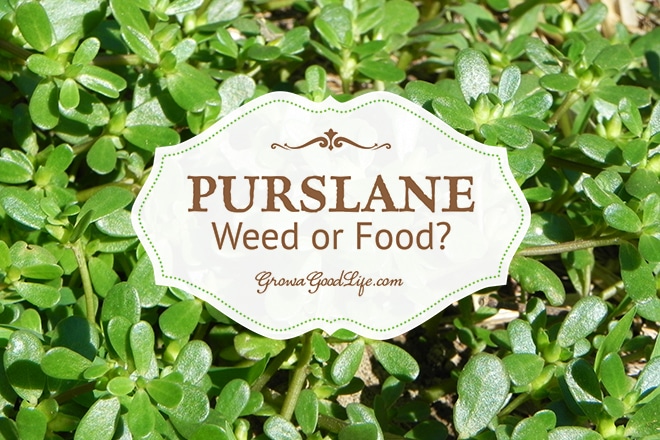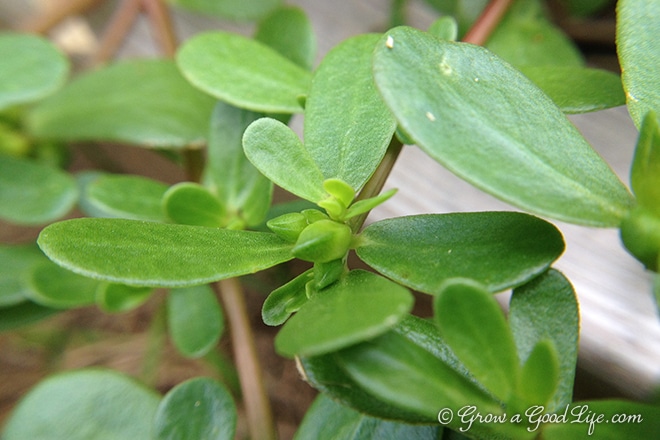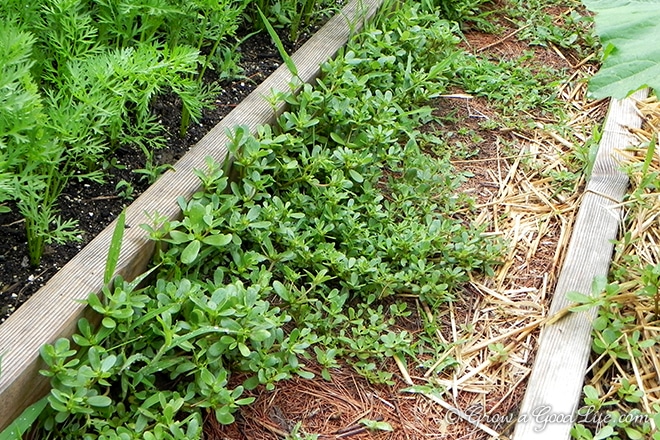Purslane: Weed it or Eat it?
This post may contain affiliate links, which means that I may receive a commission if you make a purchase using these links. As an Amazon Associate I earn from qualifying purchases.
Have you found purslane in your garden and are you wondering if you should weed it or eat it?

Common Purslane (Portulaca Oleracea), also known as pigweed, little hogweed, or Ma Chi Xian, is a low growing succulent member of the Portulacaceae family. It is considered an annual herb that grows in almost all corners of the world in various soil conditions. To most, it is a pesky weed that sprouts up between cracks in the sidewalks, in garden beds, open areas in paths.
I have received some comments on the Purslane that I am showing in the last few Harvest Monday posts July 6, 2014 and July 14, 2014. So I thought I would share some of the research and information I have learned about Purslane.

So is Purslane a weed or food?
It is all a matter of perspective…A weed is considered to be any unwelcome or troublesome plant, especially one that grows abundantly where it is not wanted. While food is any nourishing substance that is eaten, drunk, or otherwise taken into the body to sustain life, provide energy, and promote growth.
Purslane is a rather abundant in my garden this year. It is growing in the newly constructed raised beds and in the paths. I’ve been weeding it in areas where it may compete for moisture and nutrients with crops, but have allowed it to grow in corners and in paths. The weeded plants are not tossed away. I have been plucking the succulent leaves and adding them to salads, stir fry, and scrambling them up with my morning eggs.

So why am I eating a weed?
Purslane is packed with nutrition: Purslane is low in calories, high in fiber, an excellent source of the essential amino acids, and vitamins A, C and E. Purslane also has one the highest known concentrations of Omega-3 fatty acid in any plant. (source: HealthGuidance and USDA)
In his book, In Defense of Food: An Eater’s Manifesto Michael Pollan praises Purslane as one of the healthiest plants on the planet:
“Two of the most nutritious plants in the world are weeds—lamb’s quarters and purslane—and some of the healthiest traditional diets make frequent use of wild greens,” ~Michael Pollan, In Defense of Food: An Eater’s Manifesto
Purslane requires no effort to grow: Purslane grows freely and tolerates different light intensities, temperature ranges and soil types. There is no work involved in growing purslane. It is a free source of nutritious food. Purslane easily reproduces from stem pieces and seeds with no effort on our part. It’s succulent characteristic makes it very drought tolerant.
Purslane tastes good: Purslane’s succulent-like leaves have a refreshingly crisp, slightly lemon flavor with a nice crunch that make a wonderful addition to any salad. The stems have a tangy and peppery kick. Personally, I find the stems to be a little tough but the leaves are tossed onto pizza, scrambled up in eggs, added as a burger topping, and snacked on while I am in the garden.
In addition, Purslane has been used since ancient times to treat various health conditions. In Traditional Chinese Medicine, Portulaca Oleracea is called Ma Chi Xian and is used to aid in clearing heat, expelling toxins, and cooling blood. It is sour in taste and cold in nature and goes to meridians of liver and large intestine. (source: TCM Assistant and TCM Wiki)
I will continue to consume Purslane moderately in regular meals and encourage you to give this free food resource a try. I have gathered some Recipes for Purslane on Pinterest:
Follow Grow a Good Life’s board ~ Purslane Recipes ~ on Pinterest.
Further Reading:
- University of Illinois Extension. ” If you can’t beat it; eat it!”
- Chinese Herbs Healing, “Portulaca Oleracea (Purslane, Ma Chi Xian)”
- USDA National Nutrient Database. “Full Report (All Nutrients): 11427, Purslane, raw”
- UC IPM Online. “Common purslane (Portulaca oleracea)”
- Herbal Academy of New England, “Purslane – An Omega 3 Rich Vegetable”
Disclosure: Any medical information is for informational purposes only. Always exercise caution when using any wild plants and make sure you have positively identified the plant.
You May Also Like:
- Chokecherry Jelly from Foraged Fruit
- Growing Chamomile from Seed to Tea
- Wild Violet Vinegar Infusion
- Fresh Strawberry Vinaigrette Salad Dressing
- Mason Jar Italian Salad Dressing
Good planning is key to a successful vegetable garden
Whether you are new to growing your own food or have been growing a vegetable garden for years, you will benefit from some planning each year. You will find everything you need to organize and plan your vegetable garden in my PDF eBook, Grow a Good Life Guide to Planning Your Vegetable Garden.



A weed is a plant out of place. To a farmer, a rose growing in the middle of a wheat field is a weed.
Wheat sprouting in your rose garden is usually considered a weed.
I grow a bed of purslane every year. I used to cook a breakfast for the firehouse guys, they called it “Driveway Weeds & Eggs”
Purslane is delicious! My neighbor gave me some the first time I tried it and I’ve been cooking & eating it for several years.It’s sold in a local store, usually 3 bunches for .99,it’s called veryulagas(Spanish)This is how my neighbor cooks it.She says to boil it in water until tender.Drain well.Heat oil in a skillet,saute onions, tomatoes,garlic,verdulagas until onion is tender, add cilantro,season to taste with salt & pepper.
LD, I am glad you enjoy purslane! Your neighbor’s recipe sounds delicious. 🙂
I just found this blog and wanted to share that Purslane is very popular in the Middle East. My mother is Armenian from Iran, and she always made “Dondoore” and yogurt. She would pick a bunch, wash and boil it to the desired consistency (we would cut off the tougher bottom part, boil it to soften it – like spinach, but leave a touch of crunch), drain the water and chop it into small pieces. She would then get some yogurt (again, to taste, some like lots of yogurt, others like just enough yogurt to cover the Purslane) and chop up one (or a few) cloves of garlic, mix it with the yogurt, then add the Purslane. We ate it as a snack or a side salad.
It is delicious, I grew up eating it, and it tastes better the longer it sits because of the garlic. I never knew all the health benefits of the herb, but this is a very popular dish with Persians and Armenians. We do the same thing with spinach. Enjoy!!
Marge, Thank you for sharing! It sounds delicious.
There are many kinds of Purslane, all look somewhat the same, flowers are different in size and color, leaves differ in size and shape, taste slightly different, some are more tangy tasting, some more crunchy, some with stronger lemon flavor, etc. Some Purslane grow upward and some stay on the grown. I have known about Purslane for over 30 years and in my research to finding out more about this weed, though there are many different kinds of Purslane, the nutritional properties are the same. I love this amazing edible weed.
Hildi, Thank you for your comment and insight. It is fascinating that so many varieties of purslane exist. Also astonishing that we don’t consume more of this nutritious weed.
Thank you for sharing this! I get this ‘weed’ in my flower gardens, walkways, and other places. I never pick them though because I think the leaves are very pretty. I only pick ugly looking weeds. I will try eating them though this year!